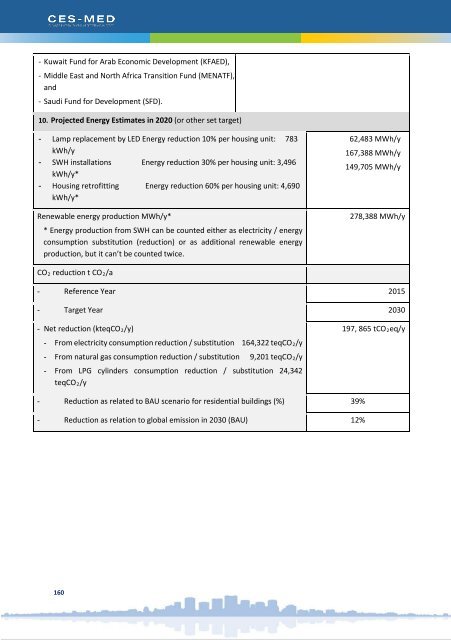280218_Luxor-Egypt SECAP Final_revised
Create successful ePaper yourself
Turn your PDF publications into a flip-book with our unique Google optimized e-Paper software.
Component 1:<br />
Phase 1: Set up the EAU – Allocating staff – Installing basic equipment (see Priority Action #6)<br />
Phase 2: Develop a specific “GRP” awareness programme mobilising women and household owners, to<br />
promote energy conservation in housing, focusing on:<br />
- Promote the adequate temperature set at home: usually homes consume large amount of energy in<br />
summer when a reasonable cooling/heating temperature can result in 20 – 30 per cent cut in energy<br />
use,<br />
- Foster behavioural changes at home: turning off lights when not in use, good management of<br />
refrigerator, washing machines’ time of use, boiling waters in kettles, and replacing classical bulbs with<br />
efficient devices such as LED lamps,<br />
- Advance use of energy efficient cooling/ heating devices: with good devices, enough to ensure efficient<br />
performance. People usually buy inexpensive equipment without taking into account the higher level of<br />
energy consumption – even with green labelling devices act, this could lower energy consumption, but<br />
more awareness is needed to emphasise on buying green label appliances,<br />
- Control elevators’ use: set operation programme and limit their use to 3 rd floor unless users have medical<br />
issue/problems,<br />
- Apply 3M sheets on windows’ glass/glazing to reduce the impact of solar radiation impinging on the<br />
external buildings, reduce cooling loads, and lower energy consumption.<br />
A rough calculation allows considering that a widespread awareness campaign could result in a 30 per cent<br />
reduction of electricity consumption (estimation being more difficult on other fluids) in 50 per cent of<br />
households.<br />
Component 2: The plan is to develop solar PV and SWHs, wherever possible and appropriate in residential<br />
buildings. All combinations are possible, from small 5 kW units on a roof to larger units of 200 kW or even<br />
more when surface available allows it:<br />
- Promote the use of SWH systems instead of the current electric water heating (EWH) systems.<br />
Currently, in most of residential buildings EWH systems are in use due to low electricity tariff.<br />
- Develop a partnership with a bank acting as a “third party investor” that will support the investment<br />
(for example through a process where the bank will cover the cost of the loan from a part of the<br />
savings allowed by the installation of PV and SWH programme.<br />
- Involve and train staff and companies that provide and sell PV and SWH systems to identify the<br />
benefits of installing such devices. The price of the SWH can be calculated and deducted virtually from<br />
the monthly electricity bill and given to the company in exchange of hot water delivery service<br />
through the installation of a SWH. This could be done for 2-3 years; the occupants will own the SWH<br />
after that period and will eventually save money from this installation.<br />
Component 3: On the long term, it would be necessary to develop a renovation programme targeting less<br />
energy efficient building, where basic buildings envelop insulation could significantly reduce energy use while<br />
improving comfort. To design and implement an adequate energy-retrofitting plan for residential buildings,<br />
the City of <strong>Luxor</strong> should engage in the following steps:<br />
- Assess the need through a detailed mapping of housing units, registering average energy consumption<br />
per square meter, date of construction and orientation,<br />
154

















